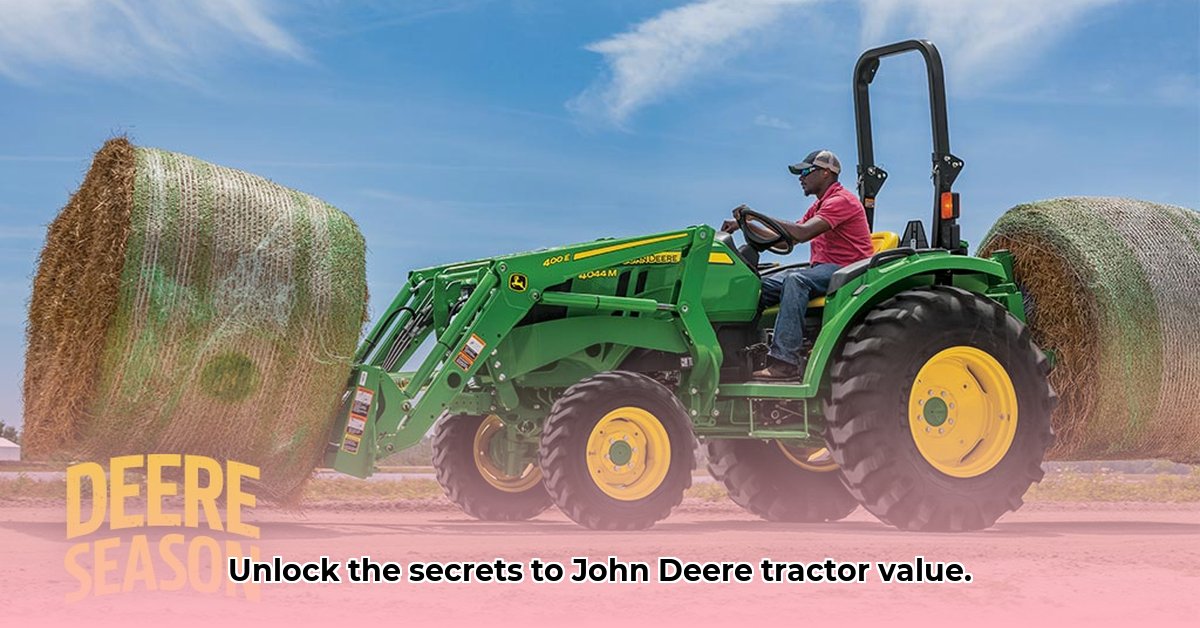
What Influences John Deere Tractor Value?
The value of a classic John Deere tractor isn't solely determined by horsepower; it's a complex interplay of factors. Understanding these will help you make informed decisions whether you're buying, selling, or simply curious about appreciation. Have you ever wondered why some tractors command far higher prices than others? Let's explore the key elements impacting value. For example, see this John Deere 5050D price guide.
Model and Year: The Significance of Heritage
Specific John Deere models and their manufacturing years significantly influence value. Rarity plays a major role; a sought-after model in excellent condition will fetch a premium. Think of it like collectible cars; some years and models are more desirable than others. Older models often appreciate more in value, particularly those in pristine condition or from limited production runs.
Condition: A Testament to Care
Condition reigns supreme. A meticulously maintained and restored tractor will always command a higher price than a neglected one. Imagine comparing a pristine classic car to one in need of significant repairs—the difference in price is considerable. Thorough restoration, documented with receipts, photos and service records, significantly elevates value.
Location: The Regional Demand Factor
Geographic location influences market value. Areas with a strong collector base or a high density of farming communities may have higher demand and thus, higher prices for certain models. Conversely, less popular models in certain areas may sell at a lower price than in high-demand regions. This mirrors the real estate market, where location hugely impacts pricing.
Restoration: Investment and Documentation
A well-documented restoration (with photos and receipts) adds significant value, but remember to consider the cost of restoration, balancing the investment against potential resale value. This process mirrors the appreciation in value of a classic car, where restoration proves the quality of work.
Determining Your Tractor's Value: A Step-by-Step Guide
This structured approach will help you accurately assess your John Deere's worth. Remember, this is a process, not a simple formula. How well you do these steps significantly influences your ultimate valuation.
Identify Your Tractor: Pinpoint the exact model and year using the serial number. Accurate identification is paramount for accurate valuation.
Conduct a Comprehensive Inspection: Thoroughly examine every aspect of the tractor, noting wear, tear, and any necessary repairs. Documentation with high-quality photographs is crucial.
Extensive Online Research: Explore online auction sites (like TractorHouse and eBay), forums, and dealer listings to find comparable tractors—matching model, year, and condition. This research provides a benchmark for valuation.
Factor in Regional Price Differences: Account for geographic location and regional demand fluctuations. A model highly valued in one region might command a lower price in another.
Analyze Restoration Expenses (if applicable): If restored, detailed documentation of costs substantiates a higher asking price. This approach is crucial, ensuring transparency and reflecting the investment.
Who Benefits From This Guide?
This guide caters to various stakeholders in the classic John Deere market. Understanding their unique needs emphasizes the broad applicability of the information contained herein.
| Stakeholder Group | Goals |
|---|---|
| Collectors | Acquire rare and valuable tractors; maximize collection value. |
| Dealers and Restorers | Optimize profit margins through smart buying and selling. |
| Investors | Identify promising investment opportunities in classic tractors. |
| Tractor Owners | Determine the true value of their John Deere tractor. |
Price Ranges: A Broad Overview
Providing precise prices is difficult due to market fluctuations. However, the below provides a general guide, remembering that several factors heavily influence the final sale price; these are estimates and not guaranteed valuations.
| Model Category | Condition | Approximate Price Range (USD) |
|---|---|---|
| Common (e.g., 4020) | Fair/Working | $5,000 - $15,000 |
| Common (e.g., 4020) | Fully Restored | $15,000 - $30,000+ |
| Rare (e.g., certain 40 series) | Fair/Working | $10,000 - $40,000+ |
| Rare (e.g., certain 40 series) | Fully Restored | $40,000+ |
Key Takeaways: Maximizing Your John Deere Investment
- Condition is paramount: A pristine, restored tractor fetches top dollar.
- Rarity matters: Unique models command higher prices.
- Market research is essential: Analyze recent auction results and comparable sales data.
- Location impacts value: Prices fluctuate regionally.
- Documentation boosts value: Service records and manuals significantly impact price.
- Parts availability is a key factor: Readily available parts enhance value.
This guide provides a foundation for understanding John Deere tractor values. Remember to conduct thorough research; the market is dynamic, and accurate valuation requires careful consideration of all contributing factors.